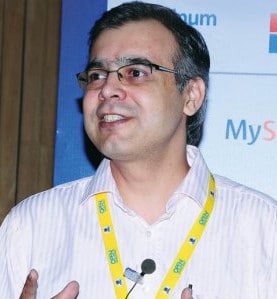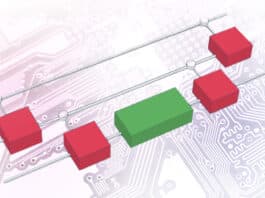Nitin Mishra, senior VP, products and solutions, Netmagic (an NTT Communications company) was at Open Source India (OSI), Bengaluru, in November last year. In a freewheeling chat with Rahul Chopra of OSFY, he shared his thoughts on what Netmagic does and what open source means to the company.
Q. Could you describe what Netmagic does?
A. Netmagic is a managed IT services provider, which provides all the components of Infrastructure-as-a-Service (IaaS), right from co-location, managed hosting to the public cloud and Storage-as-a-Service. On top of this, we provide very high quality managed services that cover databases, operating systems and certain applications.
Q How have you differentiated yourselves from players like Rackspace, or other Indian players? What you are saying is very similar to what data centre solutions providers offer. Some provide barebone services and some provide complete services. Netmagic seems to come under the latter category; so what would be your USP?
A. I think we have multiple USPs. The first is clearly the strength we have in managed services and the depth of the skills that are available. This includes our processes, rigour training, and customer engagement. That is why our customers leverage us for the IT management, support and uptime that we provide.
The second aspect is the scale that we have. Today we have nine data centres. Our flagship data centre itself has five floors, with 27871sqm (300,000 square feet) of space, and is equipped with all the latest technologies including SDN deployment. We have deployed the spine leaf architecture, which is the first of its kind in the country. We have brought in these innovations to our data centres to complement the scale that we have built.
The third USP is that we are backed by NTT Communications. So we can offer help not only in India, but we support requirements which go beyond the country. Another value addition is the experience we have in building the Nexcenter data centres.
We have been leaders in innovative service offerings. For example, in the case of security, we provide the best high-end threat management services. When it comes to the details, we have a lot of things which are more cutting-edge as compared to the providers of vanilla offerings. If you look at the larger players, I think they are focused more on very niche sectors.
Customers today are looking at optimised solutions built with SLA and expertise, and that is where we are really focusing.
Q. So do you provide anything like a Platform-as-a-Service (PaaS) or similar architecture? Or are you operating at the pure data centre level?
A. We are going to offer some PaaS services. That is on the road map. As of now, we dont plan to go into SaaS at all, but we do provide database services like MS SQL and Hadoop as a platform. MongoDB is on our roadmap. I would say we are on that journey, and we are halfway there. Over the next few quarters, we plan to give multiple offerings on PaaS as well.
Q. Where is your main data centre located?
A. We have four data centres in Mumbai, including the one that we launched in October 2015, which is the largest. We have two data centres in Vikhroli. We also have one data centre in the Bombay Stock Exchange building, specifically for algorithmic trading or high frequency trading for brokers. There is a direct fibre connection to the exchange. The latest flagship centre of ours is the one at Chandivali in Maharashtra, which, as mentioned earlier, is built over five floors. We have a large facility in Bengaluru, and at Chennai and Noida as well.
Q. What would you say is the key factor driving this group? Is it telecom, IoT, the cloud, or Digital India? Or is it the startups and the dot coms that are mushrooming?
A. One is e-commerce, which is clearly a growth engine. We host customers like Myntra, Shopclues and MakeMyTrip, among many others, on the cloud as well as on dedicated servers. As they grow, our infrastructure also grows along with them. We have been very agile and nimble, which has enabled us to work with these organisations. Second, we also see the telecom sector growing and expanding, with 4G services now available. That is more on the co-location side. So it is telecom and mobile value added services that are expanding.
Q. Do the telcos use your services? As you mentioned, they have their own pipelines and they also co-locate their data centres themselves. So how do they work with you?
A. Many of these telcos do in-house work and have their own data centres. But they do co-locate outside as well with third parties like us. There are some international telco cloud providers who prefer using third party data centres instead of building their own. We have been seeing a lot of interest from such customers as well. And even the traditional enterprises are considering migration to third party data centres. We have seen a few insurance companies as well as manufacturers completely shutting down their own data centres in search of new technology. When they make that decision, they also move to a third party data centre, where they seek a complete solution.
Q. So your team has an RoI equation for such clients? Is the typical RoI equation more about strategic advantage? Or is it about the ability to deliver more output, or reduce cost?
A. I would say it is a bit of everything, but the fall in migration cost due to a third party involvement is one of the key propositions. The cost saving is about 30-40 per cent when you move to a third party. There is simple logic behind it. To support multiple technologies 24×7, you need resources across shifts. That cost itself becomes very large when you try to do it in-house, apart from the factors of economy of scale when running and managing a facility. A second benefit is the kind of access companies get without having to pay upfront; everything is available as an operating expense. Third is the skillset our customers get to help them optimise and create cutting-edge solutions for their deployments.
Customers themselves are now aware of all these benefits, and we no longer need to convince them to outsource.
Q. Then the challenge is more about projecting Netmagic as a better option as compared to the competition, rather than having to sell the concept?
A. The first challenge is to be able to give our customers a convincing technical solution, and the second is to show how we are better than the others.
Q. How much revenue does Netmagic get from its international business?
A. Our international business contributes about 10 per cent to our total revenue. It has been growing recently, thanks to our relationship with NTT, and because we are doing remote infrastructure management for a few global customers.
Q. The government of India is now pushing for more data centres in India. Has that benefited Netmagic in any way?
A. The government is mostly setting up its own data centres. It has not opened up to third parties. We do have a few customers in the government, but the core government data centres (like NIC) are still state-owned or located in a PSU.
Q. Would it be correct to assume that most of your customers are high-end, premium customers, rather than small ones?
A. Yes, we do have more of the larger customers. But we dont really look at it as the number of employees and the revenues that the customer has. There are a lot of small companies that are big on IT and are growing pretty fast. We classify them as Ice and Nice companies — Internet-centric and non-Internet centric, respectively. The non- Internet centric are typically the mid-size and the large companies, with respect to the revenue and the scale. The Internet-centric companies may be smaller in scale but can be big customers for us.
Q. Has any startup grown with you?
A. Yes, absolutely! Cleartrip has been with us for years. India Infoline has been with us since almost the beginning of 2000. It has grown entirely along with us. Even Flipkart has been our customer for long, though the business has been more with respect to co-location. Myntra has also grown with us. So there are many examples. In fact, we have been very strong even in digital media.
Q. Do you have any special programs for startups?
A. We do offer special packages to startups for a few months, under which they can use our cloud services without any charges. That gives them time to analyse how their business has taken off, and helps them decide how to scale it up further.
Q. There is a lot of talk these days among consultants about the Internet of Things (IoT). What is your personal take on this? Do you anticipate a huge amount of business coming to cloud companies because of IoT?
A. My personal take is that it is a bit early to depend on IoT. The cloud took a few years to become mainstream. IoT will also take another one-and-a-half or two years to do so. For companies like Netmagic, the interesting business will come from the back-end and analytics.
Q. What does open source mean to Netmagic?
A. I think open source is key to our business. We have used the Swift platform for our object storage, and our monitoring set-up is also based on open source technology. We use Nagios, and we have done development on top of it. We started using open source tools for our monitoring services after experimenting with some of the commercial tools. What we like about open source is that we can tweak it the way we want to. In the case of proprietary tools, we have to wait for the next release.
In our NTT project, OpenStack is a key component, and is being used to build the cloud. We have a big team of engineers that supports CentOS and Ubuntu. We are partners with Red Hat and SUSE now, as well. In fact, we have built a big skill set, which supports Linux and open source, including Apache.
Q. Do you see a revenue stream here? How many customers come seeking an open source stack and how many prefer a proprietary stack?
A. I estimate a 55 per cent share in the demand for commercial stacks, and 45 per cent for open source software. I need to check the exact figures.
Q. So where do you see the growth coming from for Netmagic? You have mentioned that you are seeing growth coming from the telecom sector, shifting of the existing customer base and e-commerce. As I understand, these are the top three areas. Do you see any new sectors emerging?
A. I think telecom will continue to grow for some time, with 4G and video streaming gaining strength. Manufacturing is the next most important sector where we see growth coming. This sector is going through some transformation, where old technology is being replaced with the new. Next, mobile value added services will continue to provide growth. Manufacturing is a broad field, and I consider the pharma industry as a part of it.
Another area of potential growth is new age banks and the payment gateways.
Q. So what is the biggest challenge for your business?
A. The biggest is capacity management. Companies are buying services as and when they need them. As a result, many times we are not able to meet peak demands. An example would be the Diwali sales by e-commerce companies, when there is a peak in the demand for our services but, thereafter, the infra is idle. This is something we need to manage better.
Q. Lastly, what is the top technology trend you would want a typical CIO or CTO to bear in mind when it comes to the cloud, or even migrating to it?
A. This is clearly the software defined network which we used to talk about, but is now becoming a reality. When you get into a particular architecture, you realise there is a problem of scale only when you face it. And then you think you could have easily scaled your business, had the provider used a software defined network!



